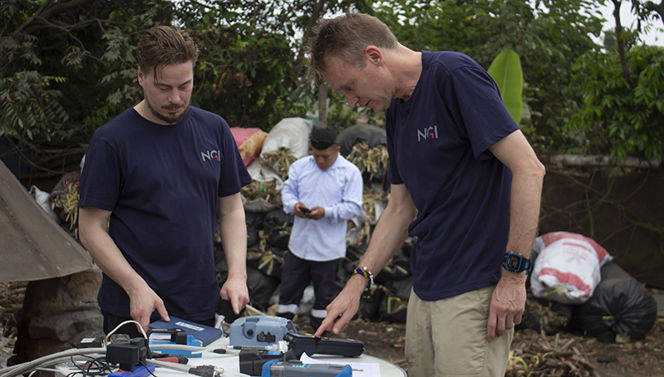Flame Curtain Kilns revolutionise biochar production and minimize methane emissions
In recent years, the urgency of addressing climate change and enhancing soil fertility has spurred interest in innovative solutions that bridge environmental conservation with sustainable agricultural practices. One such solution that has emerged is flame curtain kilns. This technology produces biochar from dry biomass while minimizing methane emissions.

Kon Tiki Flame Curtain Kiln is the most straightforward approach to making biochar. It can easily be made without cost by any small-scale actor by digging a conical soil pit. Here Erlend Sørmo (NGI) measures the temperature of the flame in a simple soil pit Kon Tiki Flame Curtain Kiln. ( NGI)
This groundbreaking advancement of producing biochar holds the potential to revolutionize the way smallholders engage in biochar production and contribute to carbon capture efforts.
Flame Curtain Kilns and Biochar Technology
Biochar, a charcoal derived from organic materials, has gained attention for its dual capacity to mitigate carbon dioxide levels in the atmosphere and improve soil fertility. Its application not only aids in removing carbon dioxide from the atmosphere but also improves soil structure, nutrient retention, and water-holding capacity. However, the biochar production process has often been accompanied by the release of greenhouse gases, particularly methane – a potent contributor to global warming.
Flame curtain kilns, a relatively recent technology for biochar production, have emerged as a favorable technology for smallholder farmers. These kilns utilize an airless combustion process that catches rising pyrolysis gases, including methane, and burns them before they are released into the atmosphere. The benefits of flame curtain kilns include their cost-effectiveness, ability to produce high-quality biochar on-site, and shorter pyrolysis cycles compared to traditional methods.
A Pivotal Breakthrough: Minimal Methane Emissions
Addressing a significant hurdle to biochar adoption, a recent study led by Gerard Cornelissen, Erlend Sørmo, Ruy Korscha Anaya de la Rosa, and Brenton Ladd showcased remarkable findings regarding methane emissions from flame curtain kilns. The study "Flame curtain kilns produce biochar from dry biomass with minimal methane emissions", carried out in Lima, Peru, has just been published in the Science of the Total Environment journal.
“Through this study, we wanted to dispel the myth about high methane emissions from Kon-Tiki systems as we have long suspected this to be a result of the feedstock being too wet”, says Erlend Sørmo, Senior advisor in the Environmental Chemistry section at NGI.
Kon Tiki Flame Curtain Kiln is the most straightforward approach to making biochar. It combines ancient principles of firemaking with modern thermodynamics. This approach democratizes biochar making, as a Kon Tiki Kiln can be easily made without cost by any small-scale actor by digging a conical soil pit. The key to making this technology work lies in how it is operated.
The research demonstrates that when dry biomass with low moisture content (less than 15%) is used as feedstock, flame curtain kilns exhibit almost negligible methane emissions, ranging from 0 to 3.6 grams per kilogram of biochar produced. This finding is a significant departure from previous estimates that reported methane emissions can be as high as 30 grams per kilogram of biochar for feedstock with 25-30% moisture, which is as much as 1.5 kg of CO2-equivalents. However, the study also underscores the influence of feedstock preparation on emissions, as wet biomass with high moisture content (greater than 40%) generated substantial methane emissions.

Erlend Sørmo and Gerard Cornelissen (NGI) measure methane emissions from two types of Kon Tiki Flame Curtain Kilns during fieldwork in Peru. ( NGI)
Implications for Sustainable Biochar Certification
Perhaps the most compelling implication of this research lies in its potential impact on certifying biochar as a viable negative emissions technology. Historically, concerns about methane emissions have led certification bodies to be cautious about including biochar from flame curtain kilns. However, Cornelissen and Sørmo's research challenges this stance. They suggest that biochar produced from dry twigs and leaves using flame curtain kilns may no longer warrant objections based on methane emissions.
Nevertheless, the study reveals that emissions such as carbon monoxide (CO) and aerosols remain noteworthy, emphasizing the need for strategic feedstock selection and exploring post-combustion methods to mitigate these emissions. While challenges persist in certifying low-tech biochar production, this research introduces a fresh perspective to the discourse on carbon balance.
Expanding Opportunities for Smallholders
The implications of flame curtain kilns extend beyond the scientific realm. Coffee farms, for instance, which are typically smallholdings, can potentially leverage this technology to transform waste biomass into biochar. This improves soil fertility and offers financial incentives for smallholders to engage in sustainable practices. Additionally, the study highlights the significance of proper feedstock choices in determining aerosol emissions, hinting at the need for a broader database of emission factors for different feedstocks.
The research is also of direct relevance for the 7,000 Tanzanian farmers who are being trained in making biochar with the flame curtain method in the realm of the ELCAP project, which is a NORAD-funded strategic partnership between NGI, NMBU, Strømme Foundation, and various other partners on climate-smart farming of maize, sorghum, sunflower, and pigeon peas.
“Carbon credits could give a direct financial incentive to small-scale farmers who live from hand to mouth”, says Gerard Cornelissen, Expert Adviser in the Sustainable Geosolutions department at NGI and professor at The Norwegian University of Life Sciences (NMBU). "It would make a significant difference for the family economy if these farmers obtained up to 40 dollars a day in carbon certificates for their biochar", he concludes
Future Directions and Potential
Flame curtain kilns present a compelling pathway as the world seeks innovative strategies to combat climate change and enhance food security. While this study sheds light on the potential of this technology, further research is needed to explore methane emissions from feedstocks and to address challenges related to certification and emission reduction.
In a world where sustainable practices are no longer optional but imperative, flame curtain kilns offer a glimpse into a future where biochar production can be both environmentally beneficial and economically viable for smallholders. As research continues to uncover their potential, these kilns could play a pivotal role in shaping a more sustainable and resilient agricultural landscape.
